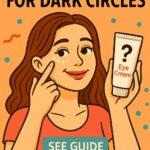
Uneven tone is one of those things that sneaks up on you. A summer of sunshine, a few stubborn post-breakout marks, or hormone shifts and suddenly you are googling “how to fade dark spots fast.” The good news is you do not need a dozen steps. A few proven actives, used consistently and protected with sunscreen, can visibly brighten patches of hyperpigmentation and help keep new spots from settling in.
Below you will find three dark-spot correctors that keep showing real-world results for our readers. We focused on formulas with derm-backed ingredients like azelaic acid, vitamin C, niacinamide, retinol, and resorcinol. Use one or two of these regularly, wear SPF every morning, and give it 8–12 weeks. That is the honest timeline for pigment to budge.
Quick Picks
| Product | Type & Key Actives | Why it’s great | Best for |
|---|---|---|---|
| Murad Rapid Dark Spot Correcting Serum | Multi-acid brightening serum with niacinamide, resorcinol, glycolic & tranexamic | Fast-acting blend targets stubborn sun spots and melasma-like patches while gently resurfacing | Moderate to stubborn spots, photo-damage |
| Paula’s Choice 10% Azelaic Acid Booster | Azelaic acid 10% + licorice + salicylic | Calms redness, fades post-acne marks, helps keep pores clear | Post-breakout PIH, redness-prone skin |
| CeraVe Resurfacing Retinol Serum | Encapsulated retinol + niacinamide + ceramides | Smooths texture and gradually brightens with barrier support | Texture + tone, beginner retinol users |
Deep Dives
Murad Rapid Dark Spot Correcting Serum
Rating: 4.7/5
Why it works: Murad stacks niacinamide for tone, resorcinol + tranexamic acid for pigment pathways, and a touch of glycolic to help active ingredients reach discolored cells. Owners report earlier brightening around week 2–4, with steady improvement through weeks 8–12 when paired with SPF. Texture is light and layers well under moisturizer and sunscreen.
Best for: Sun spots and stubborn patches that laugh at basic vitamin C alone.
Good to know: Use at night if you are using other actives. Always wear SPF 30+ in the daytime.
Paula’s Choice 10% Azelaic Acid Booster
Rating: 4.6/5
Why it works: Azelaic acid is a multitasker. It softens the look of post-acne marks, quiets redness, and has mild anti-bacterial properties. The booster texture mixes easily with a moisturizer, which is nice if you are sensitive. Fans like the clearer, calmer look it gives while slowly fading newer brown marks.
Best for: Post-inflammatory hyperpigmentation and redness-prone skin that cannot tolerate strong acids daily.
Good to know: Gentle enough for morning or night. Plays well with niacinamide. If you use a leave-on BHA, alternate nights.
CeraVe Resurfacing Retinol Serum
Rating: 4.5/5
Why it works: A beginner-friendly, encapsulated retinol smooths and gradually brightens while niacinamide supports tone and ceramides guard the barrier. Reviewers love the low-irritation feel and the way pores and old marks look more even after 6–12 weeks.
Best for: Uneven texture plus lingering post-breakout marks, especially if you’re new to retinol.
Good to know: Start 2–3 nights per week, then increase as tolerated. Moisturize well and wear sunscreen daily.
How to build a simple dark spot routine
- AM: Gentle cleanse → one brightener (vitamin C, niacinamide, or azelaic) → moisturizer → broad-spectrum SPF 30+.
- PM: Cleanse → treatment step (Murad, azelaic, or retinol) → moisturizer.
- Cadence: Most people do best with one strong brightener at a time. If you want both azelaic and retinol, alternate evenings.
- Timeline: Expect 8–12 weeks for meaningful fading. Newer PIH often lightens faster than long-standing sun spots.
See also
If dark spots showed up after breakouts, start by pairing a tone corrector with a sunscreen you will actually wear. Our readers love the options in Best Face Sunscreen for Acne-Prone Skin, and you can double down on prevention with a bright AM antioxidant from Best Vitamin C Serums. For a gentle daily hydrator that also softens redness, check Best Niacinamide Serums.
If you are just starting with actives, build tolerance first. Our Best Retinol Creams for Beginners guide covers irritation-light formulas that play nicely with brighteners. Curious about what all these ingredients actually do and how to combine them without overdoing it? Bookmark The Ultimate Ingredient Decoder for Everyday Products for quick checks before you layer.
FAQ
How long do dark-spot correctors take to work?
Most formulas need 8–12 weeks of consistent use. Newer post-acne marks often fade faster than long-standing sun damage.
Can I use a vitamin C serum and retinol together?
Yes, but most people do better splitting them. Try vitamin C in the morning and retinol at night, or alternate evenings if you are sensitive.
Which ingredient should I start with for post-acne marks?
Azelaic acid or niacinamide are great starting points. Add a gentle retinol a few nights per week if you want extra speed on texture and tone.
Do I need sunscreen if I only apply brighteners at night?
Absolutely. UV exposure deepens pigmentation and can undo weeks of progress. Wear SPF 30+ every morning, even on cloudy days.
Are hydroquinone products necessary?
Not for most people. Non-HQ options like azelaic, niacinamide, vitamin C, retinoids, resorcinol, and tranexamic acid work well with patience and sunscreen.
Affiliate disclosure: If you buy through our links, we may earn a small commission at no extra cost to you.




